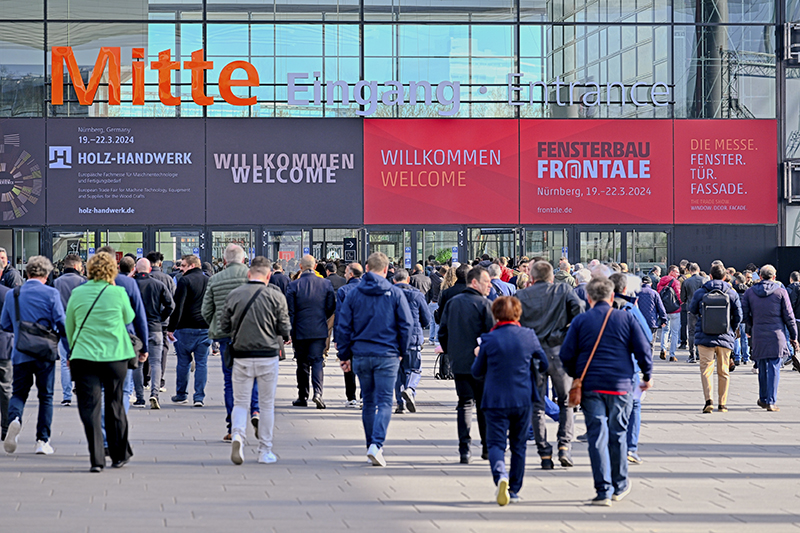Fensterbau 2024 Highlights
How global trends scale to the North American market

Fensterbau stats
- 44 countries in attendance
- 644 exhibitors
- 75,000+ visitors
- 112 countries represented
Six years have transpired since the last full-scale Fensterbau Frontale trade show. We’ve since seen a world evolved by a global pandemic and its aftermath—a market boom, rumors of a never-materialized crash, and we managed our way through supply chain and material challenges.
The event made a strong return March 19-22, in Nuremberg, Germany, with more than 600 exhibitors across the expanse of nine full halls and a reported attendance of around 75,000 overall visitors. (Note that the number of “visitors” includes exhibitors and attendees to the adjoining Holz-Handwerk trade fair and encompasses cumulative visits over the four days of the event, as well as accounts for exhibiting staff.) Still, the crowds and exhibits were telling of a healthy and engaged industry focused on networking, education and innovation.
Fensterbau reports that 44 countries were represented at the event. Among them, a contingent of North American fenestration manufacturers from Canada and the U.S. gathering observations and takeaways from a vastly different market.
Europe's trends often foreshadow what's coming to North America
What relevance does this show have for the North American market? While many of the specific trends don’t translate one-to-one—for example, European fenestration is going to have a lot more hardware and a lot more reinforcement—the challenges for fabricators can be a consistent worth exploring. “This event gives us an opportunity to see what types of capabilities they're developing based on European problems and European manufacturing challenges,” Laura Doerger-Roberts, Vinylmax Windows, says. “Those usually translate into similar challenges American fabricators have. Seeing how that technology and innovation can bring more efficiency and more consistency to our facilities is important to us.”
Further, as Marco Patermann, U.S. representative for Continental and Fux Machinery states, “Customers come from all over the world, including United States and Canada, to see what's new, what new technologies are out there, and what is coming. A lot of new technologies, finishes and services start in Europe and then move over to North America.”
Integrating automation into the manufacturing process and products themselves
In Europe, especially in Poland, sources say the level of automation is on a completely different scope. Robots run everything, even with automatic infeed for wrapping profiles, as Patermann showed Window + Door at Fensterbau. No hands necessary. Seamless welding was on display in many of the equipment booths with, again, robots running the show. But will this ever be a reality in the U.S., and do we want it to be?
“The problems that come with fabrication and the problems that come with eliminating direct labor are the same. Labor is very expensive in most of Western Europe, so we have always found that the European manufacturers are looking for more automation and looking for ways to take the time and manpower out of product,” Doerger-Roberts says. “Historically, that hasn't been a big as big of a problem in the United States. But in the past several years, the labor market has tightened up and has gotten more expensive for good consistent quality labor.”
A solution Vinylmax is working on to address this labor issue has nothing to do with machines. “We really looked at our culture to make sure we are doing the things that are required for a modern American workforce, she says, “meaning opportunities for advancement and work life balance, career path progression, better training.”
While the labor solution in the U.S. will undoubtedly be hybrid, incorporating workforce development and integrating automation, it’s incredible to see the capability of equipment and software from global vendors. “There's some really neat automation,” says Brian R. Standley, Wincore Windows & Doors. “But for me it’s more about what we're trying to do on a day-to-day basis. It just has to work for what we're trying to do as well.”
Labor and equipment trends aside, another side to automation that is very apparent in European fenestration is incorporated within the products themselves. Joe Peilert observes: “Automation is everywhere. Not just software but integrating digital technology into the hardware and operating systems. The operational side.”
We’ve seen iterations of this trying to catch on in the U.S. for the past decade. What’s different is a new level of expectation from end-users/homeowners with other factors of their lives that have since been automated—cars, appliances, and so on. “Work your supply chain backwards to start with the homeowner,” says Peilert. “What matters to them? Is it iPhone integration? ADA? With each, we have some very specific expectations.”
Companies optimistic toward investments, growth
Contrary to many signs pointing to market health, there still seems to be some broad hesitancy across the industry globally. Our sources indicate that a lot of companies are still holding back a bit in terms of investing, with what Tony Mehringer, Sturtz, calls a wait-and-see attitude. Looking at the numbers that impact the industry paints a more confident picture.
“For the future, we're likely to see some softening, a little leveling. The post-COVID hangover is going to wear off and we're going to come back to a steady market. Hopefully, what we're seeing in housing starts and the like is that the economy will continue to gain steam,” Mehringer says.
Regardless of where companies may fall on the optimism scale from wherever in the world their plants may be, channeling an energy toward adaptation and innovation may be key to seeing through all the next market fluctuations.
“We're optimistic. We're going to continue to invest in the business, to invest in the processes. That may mean new machines, or it could be new software, new ways to track efficiency, and so on,” Mehringer says. “We want to be a world-class leader in service and we're going to continue to work in that direction and try to make those things happen.”
